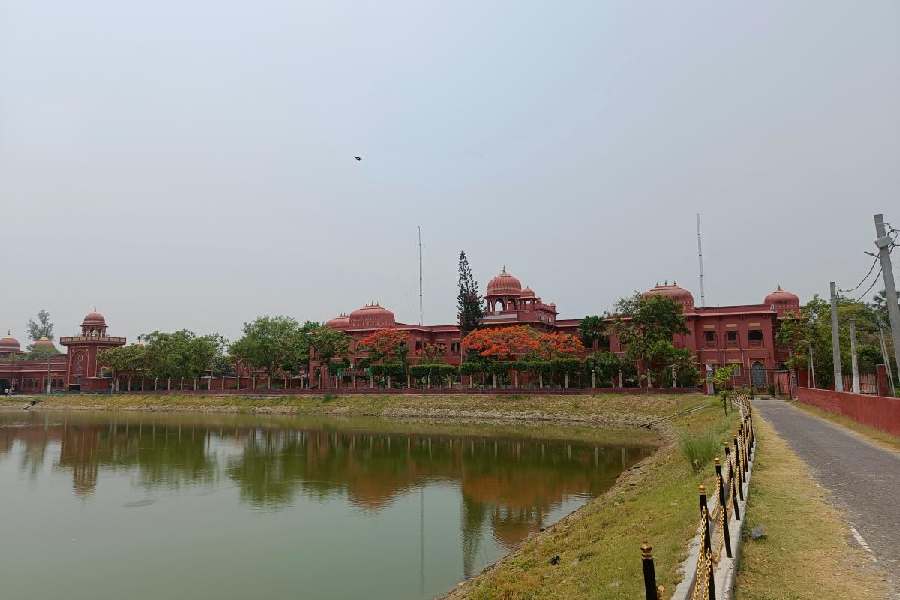Ripples spread through the Darbhanga Raj Palace lakes as the cool easterly wind, laced with the smell of rain somewhere and a bit of electioneering, caresses past.
The expansive premises are surprisingly neat and clean, lending it an incongruous, otherworldly charm. Two state universities function out of the campus. But step outside and all the glory of the seat of the Mithila state and culture ends.
And Bihar begins.
Cacophony, filth, pollution, traffic snarls, and severe waterlogging in case of rain — outside, the place reeks of rot.
“We were the centre of art, culture and power in these parts of the country — Mithila and its surroundings. Whatever was best and modern and was available in India was also present here. It was a progressive state. But things degenerated,” Maharaja Kapileshwar Singh, scion of the erstwhile Darbhanga Raj, tells The Telegraph.
Established in the 16th century, the Darbhanga Raj once spread over 10,000sqkm. It became a zamindari in the 19th century under British rule, but was counted among the largest and richest, with more powers than many princely states. The palace’s ivory collection is still said to be among the best in the world.
The Raj had its own sugar mills, railway service, aviation, irrigation system and electricity generation units but the destruction has been such that even their vestiges are difficult to find.
Singh — who’s seen at functions organised by the BJP but asserts he has “not joined any political party” — refuses to elaborate on the reasons for the downfall, because it is “a long story that would take much time to tell”.
People in other parts of the country look up to royal family descendants, but not here. Things deteriorated rapidly after the demise of Kameshwar Singh, the last full-fledged Maharaja of Darbhanga, in 1962.
“I grew up on my grandparents’ stories of the grandeur of Darbhanga. Its downfall has been due to politics and politicians, who did nothing to protect it. I really don’t know whether our votes have done anything good in the past seven decades,” says Kushagra Thakur, an engineer with a multinational firm in Pune, who is back home for the elections. “The people are also politically oriented, indisciplined and thrust politics into everything.”
The people’s tendency to not accept anything without testing it on the touchstone of logic has been attributed to the tradition of ‘dialectics’ here, from the times of Mithila’s Raja Janak, the father of Sita, to now.
“Darbhanga’s ascendancy was due to a merit-and-intellect-based culture. It was the centre of Mithila and the hub of various activities due to the Maharaja. It declined when it resorted to nepotism and casteism,” Professor Jitendra Narayan, who headed the political science department of Lalit Narayan Mithila University in Darbhanga, tells The Telegraph.
“Politicians promoted casteism for political gains. They neither batted nor wanted to preserve Darbhanga’s grandeur. Take the example of its unique drainage system that would protect the city despite being at a lower level than the nearby Bagmati river. People have now built houses on the drainage route,” Narayan adds.
Eight candidates are in the fray on this seat, spread across six Assembly segments with around 17.75 lakh voters. The main contest is billed between incumbent BJP MP Gopal Jee Thakur and RJD’s Lalit Kumar Yadav.
As in much of Bihar, clusters of people are seen busy discussing caste equations, because this is one constituency where Brahmins outnumber all other groupings. Next to them are the Muslims, Mallah (boat people and fisherfolk), followed by others. The two main contestants are also weighed.
“Gopal was polite till he was a simple BJP worker, but acquired airs after becoming an MP. He now doesn’t mingle with his own party workers, nor goes door-to-door to listen to the voters. Lalit, on the other hand, is good on both fronts,” says Vijay Panjiyar, a shopkeeper at Beta Chowk in Darbhanga town.
A couple of kilometres away, the Khadi Gramodyog centre of Darbhanga is also in a shambles. The staff rue that the Narendra Modi government has stopped central aid ever since coming to power and the industry is dying fast.
Accountant Shiveshwar Jha says that from a time when the centre had 4,000 charkhas (spinning wheels), 200 weavers, 20 tailors and five dyers, besides thousands of women who would produce handspun threads, today there are only 22 staff, five weavers and a dyer.
“We now barely supply clothes worth ₹7lakh to ₹8 lakh per annum. We hardly get ₹5,000-6,000 per month and can barely make ends meet,” he adds.
But voters still hold out hope. “The future of Darbhanga could be bright. It has an airport, a good rail-and-road network, colleges and fertile land. We need politicians who will pay attention,” says advocate Kumar Sarvesh.
Darbhanga votes today










